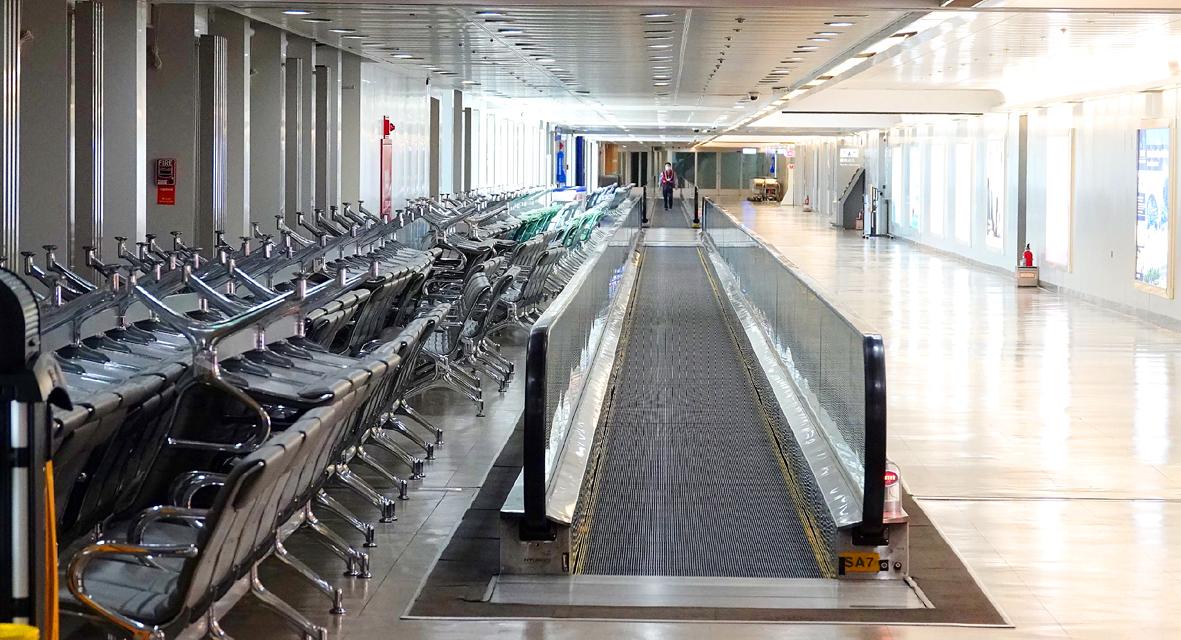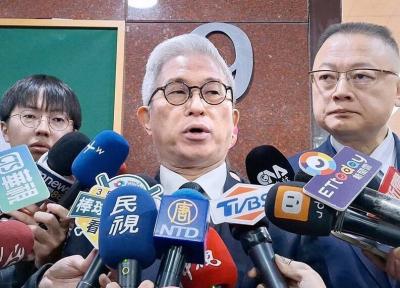Starting today, more than half of the boarding gates at the Taiwan Taoyuan International Airport are to be closed as the COVID-19 pandemic has led to a sharp decline in passenger traffic at the nation’s largest airport, Minister of Transportation and Communications Lin Chia-lung (林佳龍) said yesterday.
Lin spoke to reporters about the ministry’s decision after attending a ceremony in New Taipei City’s Tamsui District (淡水) to mark the launch of the construction of the Tamkang Bridge (淡江大橋).
“Passenger arrivals at the airport have dropped below 1,000 per day. We have been renovating some of the airport’s facilities and would start closing some boarding gates. Passengers would enter and depart through designated gates, which will allow us to save on personnel and maintenance costs,” Lin said.

Photo: Tony Yao, Taipei Times
Airport facilities that are under renovation include runways and taxiways, as well as restrooms, ceilings and floors inside the terminals, he said, adding that closing 20 of the 38 boarding gates would quicken the pace of renovations.
Asked why the ministry did not choose to close one terminal and leave the other one open, Lin said that shutting down one terminal would prevent airport employees from accessing facilities in the closed terminal.
Airport operator Taoyuan International Airport Corp (TIAC) said that it would close boarding gates A1 to A5 and B1 to B5 in Terminal One, and C6 to C10 and D6 to D10 in Terminal Two, adding that these gates are located at the far ends of the two terminals.
The remaining 18 gates would function normally, it said.
Not only would the measure meet the current demand, but it would also allow the airport company to more easily adjust usage of the boarding gates, it said, adding that it is a better cost-saving measure than shutting down one of the terminals.
Lin added that the ministry has approved TIAC’s proposed changes to the design of Terminal Three and submitted the proposal to the Executive Yuan for final approval.
If approved by the Cabinet, TIAC would be able to place the project on a public tender by the end of this year, Lin said.
The company has also adjusted the budget for the Terminal Three project from a more practical perspective, Lin said, adding that the exact amount is still being calculated.
The company has kept the design of a cloud-shaped ceiling for the terminal and eliminated some of the more complex details, which would make the terminal easier to build and maintain, Lin said.
It would be the fourth time that TIAC would be placing the project for tender, as the three attempts last year failed to attract any bidders, despite an increase in construction budget.
Under the new proposal, the budget allocated for the Terminal Three and other peripheral constructions would be about NT$95 billion (US$3.15 billion), of which NT$53.7 billion would be used to build the terminal.
Terminal Three would be opened in three stages, with the north concourse scheduled to be completed by 2024, the company said.
The main terminal is scheduled to begin trial operation in 2025, and the south concourse is to be completed by 2026, it said.

Taiwan is to commence mass production of the Tien Kung (天弓, “Sky Bow”) III, IV and V missiles by the second quarter of this year if the legislature approves the government’s NT$1.25 trillion (US$39.78 billion) special defense budget, an official said yesterday. Commenting on condition of anonymity, a defense official with knowledge of the matter said that the advanced systems are expected to provide crucial capabilities against ballistic and cruise missiles for the proposed “T-Dome,” an advanced, multi-layered air defense network. The Tien Kung III is an air defense missile with a maximum interception altitude of 35km. The Tien Kung IV and V

The disruption of 941 flights in and out of Taiwan due to China’s large-scale military exercises was no accident, but rather the result of a “quasi-blockade” used to simulate creating the air and sea routes needed for an amphibious landing, a military expert said. The disruptions occurred on Tuesday and lasted about 10 hours as China conducted live-fire drills in the Taiwan Strait. The Civil Aviation Administration (CAA) said the exercises affected 857 international flights and 84 domestic flights, affecting more than 100,000 travelers. Su Tzu-yun (蘇紫雲), a research fellow at the government-sponsored Institute for National Defense and Security Research, said the air

A strong continental cold air mass is to bring pollutants to Taiwan from tomorrow, the Ministry of Environment said today, as it issued an “orange” air quality alert for most of the country. All of Taiwan except for Hualien and Taitung counties is to be under an “orange” air quality alert tomorrow, indicating air quality that is unhealthy for sensitive groups. In China, areas from Shandong to Shanghai have been enveloped in haze since Saturday, the ministry said in a news release. Yesterday, hourly concentrations of PM2.5 in these areas ranged from 65 to 160 micrograms per cubic meter (mg/m³), and pollutants were

Taiwan’s armed forces have established response protocols for a wide range of sudden contingencies, including the “Wan Chun Plan” to protect the head of state, the Ministry of Defense (MND) said today. After US President Donald Trump on Saturday launched a series of airstrikes in Venezuela and kidnapped Venezuelan President Nicolas Maduro, concerns have been raised as to whether China would launch a similar “decapitation strike” on Taiwan. The armed forces regularly coordinate with relevant agencies and practice drills to ensure preparedness for a wide range of scenarios, Vice Minister of National Defense Hsu Szu-chien (徐斯儉) told reporters before a